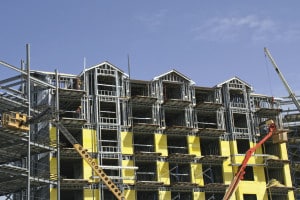When you are grappling with a problem as big as Massachusetts’ housing crisis, incremental, small-bore solutions just won’t cut it. In fact, such feel good efforts may even do more harm than good, creating the illusion of real action when nothing much is really being done.
A case in point is the state’s once much ballyhooed effort to offer financial incentives to suburbs and cities that rezoned sites for new apartments and condominiums, better known as 40R.
Housing market guru Barry Bluestone and a fellow Northeastern University prof hailed 40R when it was launched in 2004 as the “most radical reform in housing policy in the commonwealth in decades.”
Only if that were true.
Bluestone and Daryl Hellman predicted in an op-ed in The Boston Globe that the new 40R law could pave the way for nearly 30,000 new housing units over the coming decade.
Fourteen years later, just 3,500 new apartments and condos have been built – a far cry from the hundreds of thousands of new homes of all types that will be needed over the coming decades. And that’s just to keep pace with rising demand – never mind trying to build enough to actually bring down prices, which are already crushingly high for too many families.
What Bluestone and Hellman, back in that long-ago op-ed, referred to as the law’s “powerful set of financial incentives” apparently weren’t so powerful after all.
To date, the state has doled out $20.2 million in incentive payments to communities which create “smart zone” districts where new, mainly multifamily housing can be built, according to a recent review of 40R by the Citizens Housing and Planning Association, a nonprofit advocacy group.
But so far, there has been a whole lot more zoning than building. More than half the money, $10.5 million, has gone to support planning efforts that have created new zoning districts where the vast majority of potential units – more than 15,000 – have yet to be built.
And that’s just scraping the surface on the rather lackluster performance of a law some argued would prove to be a game-changer in tackling the housing crisis.
CHAPA somewhat gently raises questions about the effectiveness of 40R, with phrases like “while here is much to celebrate, the law is not fully achieving its potential.”
But the facts laid out by the report are rather damning.
Suburban Obstruction
The suburbs have been a major obstacle in efforts to spur the kind of large-scale new housing construction needed to solve Greater Boston’s housing woes. Of the actual new housing development there has been under 40R, many of the largest projects have been in the state’s constellation of old mill towns and older industrial cities like Haverhill, Brockton, Lawrence, Lowell and Fitchburg, among others, the report finds.
Then there are chestnuts like these:
- Just 5 percent of all the new apartments and condos envisioned for these smart growth districts are actually in Greater Boston communities that are in the most desperate need of housing, CHAPA finds.
- Half the new homes built aren’t near public transportation, which would seem to clash with the very definition of what a publicly subsidized “smart growth” district should be.
- Half of the new condos and apartments supposedly built with the help of 40R were in already approved projects and developments and would have been built anyway;
- Most of the units built have been smaller – as in not meant for families – with just 4 percent having three bedrooms.
If that is not missing the mark, then I don’t know what is.
Once touted as the potential solution to Greater Boston’s housing wows, 40R has instead degenerated into a perfect example of the wishful thinking and incrementalism with which the Legislature and a parade of governors on down to Gov. Charlie Baker have attempted to deal with our region’s housing mess.
While supporters may argue the new housing built under 40R is at least better than nothing, the law and similar, small-bore proposals like 40R may actually do more damage than good; they maintain the illusion that state and local leaders are taking meaningful steps to address high housing costs.
Unfortunately, the latest crop of solution put forth by Baker and Legislative leaders appear to be variations on the 40R theme, hoping to sweet talk or gently cajole suburbs and towns into allowing more housing to be built.
Big problems calls for big ideas and big solutions that may very well piss off a lot of people, especially the NIMBY crowd that has so effectively blocked new housing development in Boston’s suburbs for decades.
Now is the time for the most popular governor in America to expend some political capital pushing some real solutions to the housing crisis. Here’s looking at you, Charlie.
Until then, we can expect more price increases and more families priced out of the market.
Scott Van Voorhis is Banker & Tradesman’s columnist; opinions expressed are his own. He may be reached at sbvanvoorhis@hotmail.com.




 |
| 


